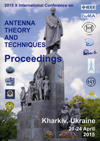Comparative analysis of two variants of smart antennas for base station of mobile radio communication
DOI:
https://doi.org/10.1109/ICATT.2015.7136817Keywords:
smart-antenna, base station, effectiveness, noiseAbstract
The analysis of spatial processing effectiveness for the two variants of smart-antenna is studied: multi-beam antenna array with beam switching and adaptive antenna array. Efficiency is measured by the output signal-to-noise ratio. The boundary values of efficiency for arbitrary noise conditions are set. The recommendations for practical application are formulated.References
BADANIS, K.A.; IOANIDES, P.I. Introduction to Smart Antennas. Moscow: Technosphere, 2012.
SHIRMAN, J.D.; MANZHOS, V.N. Theory and Technique of Processing Radar Information on the Background of Noise. Moscow: Radio i Svyaz, 1981.
HORN, R.; JOHNSON, C. Matrix Analysis. Moscow: Mir, 1989.
MONZINGO, R.A.; MILLER, T.W. Adaptive Arrays: Introduction to the Theory. Moscow: Radio i Svyaz, 1986.
KOBZEV, A.V.; KHACHATUROV, V.R. The effectiveness of the adaptive spatial signal processing in antenna arrays with a large number noise sources. Proc. of 2nd Int. Radio Elect. Forum, ANPRE. Kharkiv: KNURE, 2005.
Published
2015-04-25
Issue
Section
AA, AAA, smart antennas and signal processing

